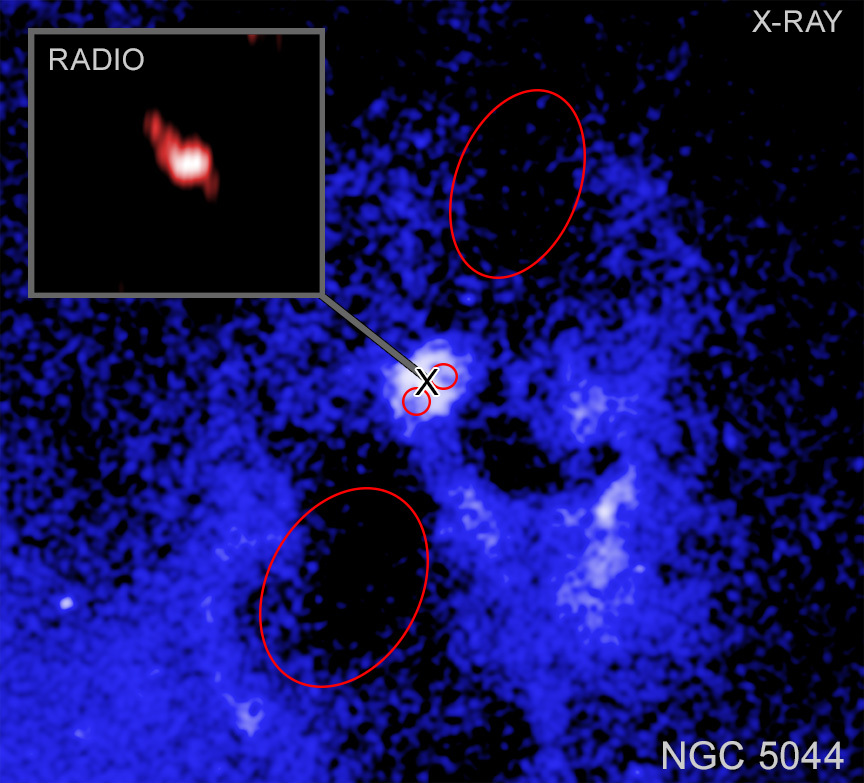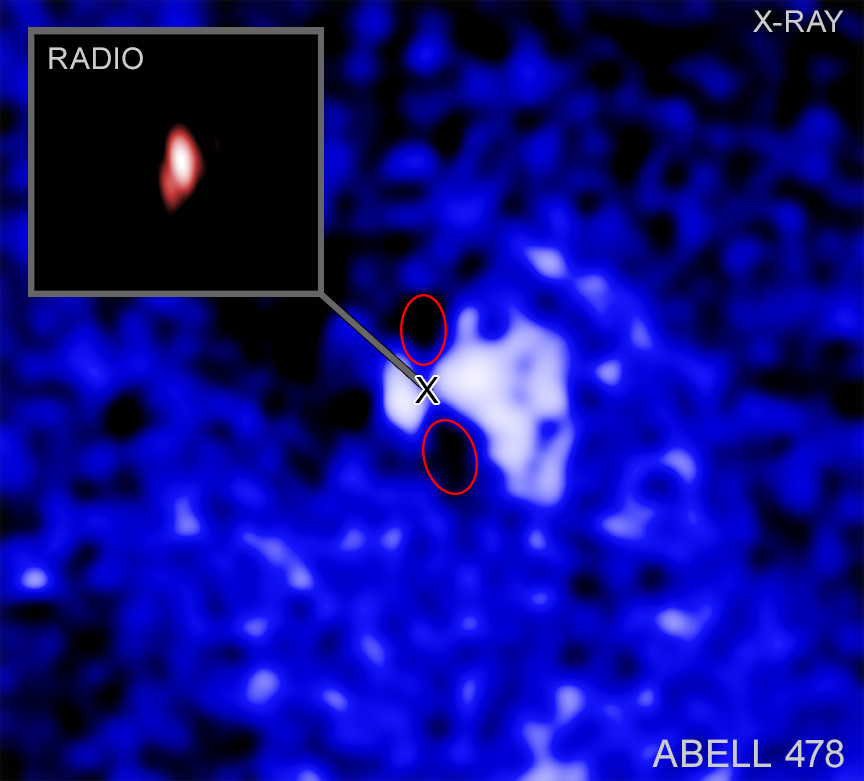12.06.2024
Heavyweight black holes sometimes topple over on their sides, according to X-ray and radio observations of the jets these black holes power.

The central galaxy of the cluster NGC 5044 hosts a supermassive black hole (position marked with an "x") that's emitting a vast jet of plasma. The direction of this jet is shown in the radio inset. However, the X-rays (blue) reveal a bubble blown by a previous jet (red ellipses) that was pointed in a completely different direction.
X-ray: NASA / CXC / Univ. of Bologna / F. Ubertosi; Insets Radio: NSF / NRAO / VLBA; Wide field Image: Optical/IR: Univ. of Hawaii / Pan-STARRS; Image Processing: NASA / CXC / SAO / N. Wolk
Supermassive black holes with the gravitational heft of millions or even billions of Suns can power speedy trains of plasma that exit their host galaxy. These jets shoot out from the black holes’ poles and into intergalactic space, crossing millions of light-years.
While these powerful and extensive jets appear long-lived, they’re not — they actually turn on and off over time, leaving behind them an echo of their power. Now, a new, comprehensive study of more than a dozen galaxy groups uses those ancient records to show that some supermassive black holes might be changing surprisingly quickly, tilting to point their jets in a completely different direction.
JETS AND BUBBLES
All galaxies are surrounded by a halo of hot gas, thrown out during periods of heavy star formation and supernova explosions. In a galactic grouping, this hot gas typically envelopes the whole system. Jets sweep up this gas, leaving behind bubbles of largely empty space. These bubbles then “rise,” their buoyancy carrying them gently away from the galaxy.
These plasma-blown bubbles record the activity of jets from times gone by. Using the Chandra X-ray Observatory, Francesco Ubertosi (University of Bologna, Italy) and colleagues could read those records for 16 galaxy groups and clusters and compare them against a radio image of the present-day jet, from the Very Long Baseline Array in New Mexico. They published their results in the Astrophysical Journal.
“Our targets are surrounded by the cluster’s hot gas, the ‘intracluster medium’, where the imprints of jets are visible as holes (or cavities) in the gas,” Ubertosi explains.
What they found is that some of these jets changed direction — by a lot. In these cases, the current jets point in a completely different direction compared to the jets of ancient times. The implications are huge, literally: The behemoth black holes themselves might be shifting their axis of rotation over remarkably short time periods.
READING ANCIENT RECORDS
Determining the direction of current jets is straightforward. Ringed by magnetic fields, present-day jets are straight and narrow, at least until they plow into the gas around the galaxy. But finding the direction of ancient jets isn’t so easy. The bubbles they made may drift sideways after they form as well as rising “up,” away from the galaxy.
There are projection effects to account for, too. If we’re looking straight down a present-day jet, the angle between that jet and any ancient bubbles that appear off to its side may appear larger than it really is. The group mitigates these projection effects in multiple ways, among them by starting out only with those galaxy groupings in which the jets are clearly directed off to the side rather than toward Earth.
Ultimately, in four of the 16 systems that the team examined, the present-day jet points diagonally (by more than 45 degrees) away from all the bubbles of previous jets that exited that galaxy. And of all the jet-bubble pairs under investigation, about a third show such large misalignments. In fact, in a surprising number of them, the jet is oriented almost perpendicular to the ancient bubbles. (It’s worth noting that because of things like sideways drift and projection effects, the team can only pick up big changes in the angle between jets and bubbles.)
“Their work is able to quantify the misalignments and rule out environmental influences in a more quantitative manner [than previous studies],” says Preeti Kharb (Tata Institute of Fundamental Research), who was not involved in the current study but has studied this phenomenon in the past. “This is what makes the paper interesting and impactful.”

Similar to NGC 5044, the galaxy cluster Abell 478 hosts a supermassive black hole that powers a plasma jet. And while the bubbles appear smaller, they, too, suggest previous jets pointed in a different direction from the one currently seen in the radio inset.
X-ray: NASA / CXC / Univ. of Bologna / F. Ubertosi; Insets Radio: NSF / NRAO / VLBA; Wide field Image: Optical/IR: Univ. of Hawaii / Pan-STARRS; Image Processing: NASA / CXC / SAO / N. Wolk
A NEW SPIN
What would cause a black hole with the heft of millions of Suns to lean its axis of rotation, sometimes toppling all the way to its side? Black holes may sometimes precess, wobbling on their rotation axis like a top, but such changes wouldn’t be so large. Ubertosi and his colleagues also rule out that intergalactic winds or other environmental effects shift the bubbles created by ancient jets. Instead, they suggest that there has been a change in the black hole’s feeding pattern, such as the rate or direction from which gas falls into the black hole — in some cases within only 1 million years, an astronomical blink of the eye.
Ubertosi’s team acknowledges in their study that they can’t “exhaustively explain the observed properties of the jet reorientation mechanism” — the changes are too great and too fast. But Kharb also notes that determining how fast these black holes typically feed or how long such meals typically last is itself notoriously difficult. “The answers may lie in the future,” she agrees, “with better models, simulations, and observations.”
Quelle: Sky&Telescope
